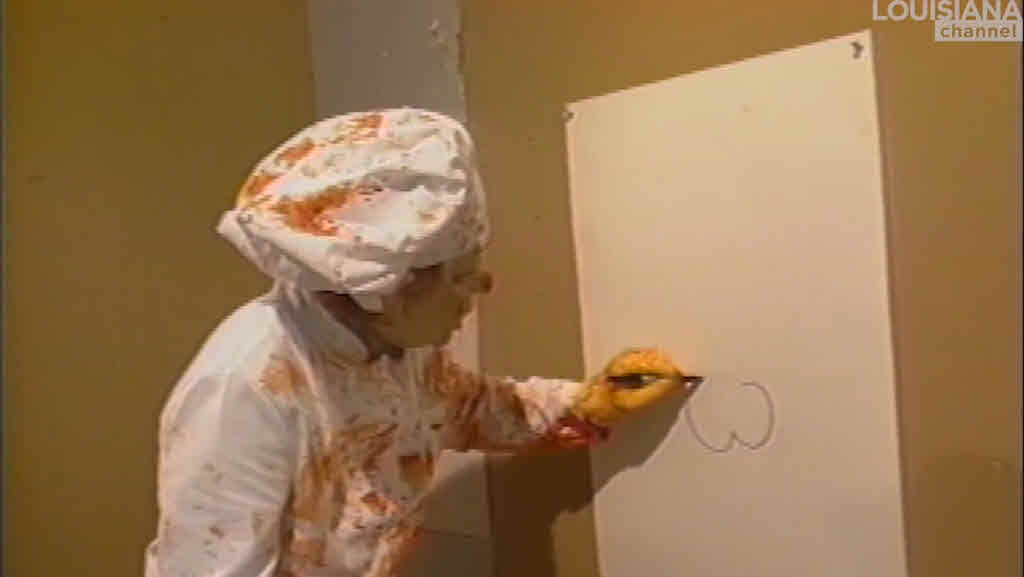VIDEO:Becoming Paul McCarthy So Much Is About Discovery (Part II)
 Marc-Christoph Wagner went to Los Angeles and visited Paul McCarthy, one of the most influential and groundbreaking contemporary American artists, known for his wide-ranging and often disturbing oeuvre. In this video, which is the second part of a series of three videos with McCarthy, he talks about using his body as a sculpture, appropriating characters, and the reason behind the overt violence in his work. Together, the three videos offer a unique presentation of the artist’s work and artistic process.
Marc-Christoph Wagner went to Los Angeles and visited Paul McCarthy, one of the most influential and groundbreaking contemporary American artists, known for his wide-ranging and often disturbing oeuvre. In this video, which is the second part of a series of three videos with McCarthy, he talks about using his body as a sculpture, appropriating characters, and the reason behind the overt violence in his work. Together, the three videos offer a unique presentation of the artist’s work and artistic process.
“It’s not a world around the art world. It’s a world around artists”, McCarthy says of the alternative art world in Los Angeles between 1970-1990, where few artists had a gallery, and it was more about e.g. performance. He had stopped doing public performances around 1983, which was also the time when he began using sets. In 1991, he started incorporating rubber- and wax figures, which he saw as directly connected to the “fucked up utopia” of Disney Land. Frequently using himself in his work, McCarthy explains how this derives from the notion of the body as material – as sculpture – and wanting to be part of the experience: “Sculptures are performances.” Putting on a character, he continues, provided him with the freedom to remove himself from the restrictions that he put on himself, and to describe his view of the human situation. In continuation of this, McCarthy talks about how his work displays “male conditioning” as a symbol of how “America looks at itself, and the rest of the world watches America. And they have no idea what’s going on on the outside”. What he does, McCarthy explains, is constructing and examining the absurdity in the world.
“Somebody’s got to look at them,” McCarthy says of the explicit violence in his work, which he argues is there because it is blatantly present in the world. An example is his film “CSSC: Coach Stage Stage Coach: (2017): “Part of what this is, in this piece, is about media. Part of it is about what’s being shown to us. In some personal, subjective way, and in some objective cultural critique, in both things, deconstructing that. For myself, and for others”. Finally, McCarthy describes how the trajectory of the art world changed for him around 2000, when he entered a privileged position. This enabled him to work with the moving image collaboratively, in a studio resembling a sound stage: “What happens in there is a form of a dream”. McCarthy points to the sets in his studio and adds that he refers to them as skulls: “It’s the set as a skull with a dream that is contained”.
Paul McCarthy (b. 1945) is an American artist. McCarthy’s often provocative works – frequently taking aim at consumerism, popular culture, and our innermost fears and neuroses – encompass performance, photography, film, multimedia installations, sculpture, drawing and painting. He regularly appropriates icons of popular culture including Santa Claus and Snow White, recasting them as violent, malicious and depraved. McCarthy’s work has been exhibited at prominent venues worldwide, and solo exhibitions have been held at Monnaie de Paris, Neue Nationalgalerie in Berlin, Whitney Museum in New York, and Moderna Museet in Stockholm, among others. He has also participated in the Berlin Biennial (2006), the Whitney Biennial (1995, 1997, 2004), and the Venice Biennale (1993, 1999, 2001).
Paul McCarthy. So Much Is About Discovery, interview by Marc-Christoph, Camera: Rasmus Quistgaard, Produced by Roxanne Bagheshirin Lærkesen and Marc-Christoph Wagner, Edited by Roxanne Bagheshirin Lærkesen, All works shown in the video © Paul McCarthy, © Louisiana Channel, Louisiana Museum of Modern Art, 2020, Supported by Nordea fonden
